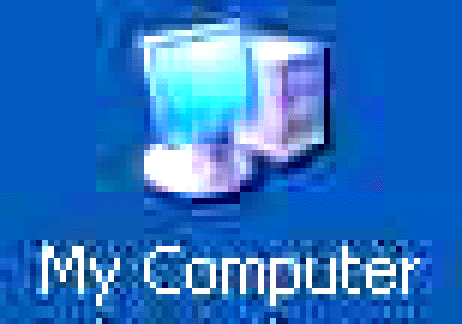View current page
...more recent posts
Paul Slocum suggests using knitPro to upload bad JPEG images so they could be rendered as cross stitch or needlepoint projects. Good idea, but man, that would be difficult to pull off. My sense is the stitched piece would have to be both enormous and extremely detailed to show the horrible "bicubic mush" that results from poor compression (which only the extremely perverse are apt to find funny anyway). Nevertheless, I have a candidate: it's a late Op Art piece by Julian Stanczak on the Stefan Stux website [Since removed]. In real life those stripes are super hard-edged, but on the Web, well...
UPDATE: Here's Paul's draft of a proposed "bad JPEG" fiber art project. He has more to say about it in the comments. I'll be away from the computer for a while but the obvious next step is to run this through knitPro.

More opinions on what the Stanczak image suffers from would be welcome--Paul pegs it as a bad resolution issue rather than a too much compression issue. I realize it's hard if you haven't seen the actual painting, but assume it's a black and white image with razor sharp lines. The whole thing is out of focus but mushy spots with added color at regular intervals look like the type of thing you see when saving something too many times at the "low quality" setting. It's important to know why things are an utter failure at communicating.
UPDATE 2: Another comment, from Dan, persuasively identifies the problem with the Stanczak image as one of bad resolution, not bad compression, but it's academic now because Stux has removed the murky black and white pic from its website. A new show of Stanczak work opens soon so I'm sure it was because of that. For bad jpegs of famous Canadian paintings, please see this post on Sally McKay's weblog, which she explains was inspired by a now somewhat quaint 1953 article by George Elliot warning that art should not be shown on television. " A painting needs an intellectual presence before it can work its magic. Placing anything between the viewer and the painting kills the viewer ."
Dubious NY Times Op Ed of the Week. Here's what seems to be the gist of Simon Singh's argument regarding what he calls Albert Einstein's "greatest failure" (not really sure what Singh is saying--and if you thought the "failure" was E's inability to find the unified field theory you're wrong):
1. Albert Einstein published papers in the same year (1905) proving the existence of the atom, showing the validity of quantum physics and introducing special relativity. He was not a "perfect genius," however.Previous Dubious NY Times Op Eds:
2. We can learn much from his greatest failure, which was hypothesizing antigravity to justify his stubborn belief that the universe neither expanded or contracted.
3. We now know the universe expands after the big bang; Einstein eventually admitted his error.
4. Except it turns out he called it correctly after all. Scientists now believe that a propulsive force called "dark energy" makes the universe keep expanding instead of collapsing in a big crunch.
5. Except Einstein wasn't talking about an expanding universe but a steady state universe, one that just sits there, making his notion of antigravity seem not very applicable to the current model.
6. So we actually don't learn much from Einstein's being wrong. The reason he's a "better than perfect genius" is he admits his mistakes, which is a very good quality.
1. The tsunami had nothing to do with restoring balance to the ecosystem but it's really cool to talk about Gaia.
2. We shouldn't do something because it's right but because scientists have learned monkeys do it.
"Pops at 49" [mp3 removed]. Noisy, dirty micro-trance. If it was a car someone would write "wash me" on it. Pops commencing at :49 are pretty jarring but as Pee Wee Herman would say, "I meant to do that" (I think); gratuitous filter sweep at 1:49 takes you to climax, meaning the loud end of the song.
